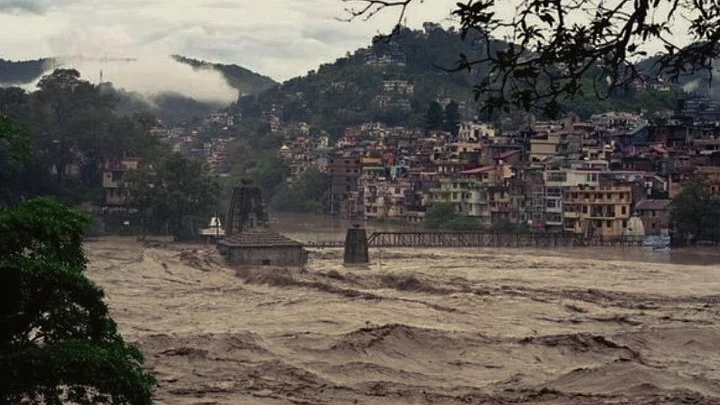Recent events in Himachal Pradesh have sounded a piercing alarm about the looming threats of climate change.
The tranquil Subathu region was jolted by a cloudburst, sending a torrent of debris and water, triggering fears of house collapses among the inhabitants. Vehicles were swept away in the surge, underscoring the brute force of this natural upheaval.
The incident's immediacy vividly illustrates the peril posed by extreme weather events. Compounding the issue, heavy downpours induced landslides, rendering roads impassable across the state. The crucial National Highway 21 Mandi-Kullu route, coursing via the Pandoh dam, bore the brunt, disrupting both movement and connectivity. The rupture in infrastructure highlights how climatic upheavals can disrupt daily routines, economic activities, and regional ties.
A consequential casualty of the deluge was the Balad River’s water levels, resulting in the collapse of a pivotal bridge in Baddi. The ramifications spanned far beyond the physical, severing connections between Baddi's industrial hub and Haryana, alongside Chandigarh. This rupture is a stark reminder of how climate-induced events can cripple normal life and choke economic corridors.
The India Meteorological Department (IMD), foreseeing the ordeal, issued an orange alert, predicting intense rainfall in isolated pockets between August 22 and 24, 2023. Districts encompassing Kangra, Chamba, Hamirpur, Mandi Bilaspur, Solan, Shimla, and Kullu were poised to bear the brunt of this climatic fury. The prediction of accompanying thunderstorms amplifies the specter of extreme weather and its cascading implications.
Educational institutions in afflicted areas, including Kangra's Dharamshala and Shimla, were forced to shut their doors owing to relentless rain and landslides. This underscores how such events can disrupt daily life and access to education, a critical cornerstone of society.
Himachal's Struggle Against Freak Weather Events
The Himachal Pradesh State Disaster Management Authority vigilantly monitored the situation, offering emergency helplines for those in need. The deployment of heavy machinery to vulnerable areas poised for landslides and road closures underscores a proactive stance toward disaster mitigation.
A concerted response from the authorities was evident. Traffic management strategies and detours were swiftly enacted to safeguard the populace. However, amidst these events, the state's Revenue Minister lamented substantial losses, pegging the toll from public and private property damages at a staggering 10,000 crore.
Heartbreakingly, lives were also lost, with fatalities, missing persons, and injuries casting a sombre hue over these calamities, a stark reminder of the human toll exacted by extreme weather events.
Himachal Pradesh's ordeal presents an unignorable truth: climate change is a reckoning force. Severe weather occurrences such as cloudbursts, heavy rainfall, landslides, and flooding have escalated in frequency and intensity, leaving devastation in their wake.
It's imperative to foster adaptation and mitigation strategies to tackle climate change's inexorable impact on vulnerable zones like Himachal Pradesh. This harrowing episode must galvanise action, for the consequences of inaction are far too perilous to ignore.
Monsoon Mayhem: A Dire Glimpse of Climate Change
The onslaught of extreme weather events in Himachal Pradesh presents a troubling narrative that resonates with the escalating impacts of climate change. As the monsoon rains began on June 24, the Himalayan state has been subjected to relentless torrential downpours, resulting in a grim toll of 217 lives lost and an estimated economic loss exceeding Rs 10,000 crore.
These staggering figures cast an ominous shadow over the region, prompting a deeper examination of the link between these disastrous events and the changing climate. The mounting evidence points to a changing climate landscape that amplifies the intensity and frequency of such extreme weather phenomena. While the immediate triggers of these events can be complex and multifaceted, there is a growing consensus among experts that climate change serves as a potent catalyst.
One notable factor is the warming of the Earth's atmosphere, leading to increased evaporation from oceans and land surfaces, fueling monsoon rainfall's intensity. The higher temperatures provide more energy to the atmosphere, resulting in the accumulation of moisture released during heavy rainfalls. This phenomenon aligns with the torrential rains that have battered Himachal Pradesh, causing widespread devastation. The shifting climate patterns also contribute to the erratic behaviour of monsoons.
Changing temperature gradients in the oceans, particularly the Indian Ocean, can disrupt the traditional monsoon patterns. Such disruptions can lead to prolonged periods of heavy rainfall, as witnessed in Himachal Pradesh, where the monsoon fury seems unrelenting. The fact that emerging concerns point towards recurring instances of intense rainfall aligns with projections of climate models that indicate an increase in extreme precipitation events due to global warming.
Himalayan Vulnerability and Call for Climate Resilience
The vulnerability of the Himalayan states in India further exacerbates the impacts of these events. Deforestation, urbanisation, and poor land management practices can exacerbate the risks of landslides and flooding during heavy rains. These factors and the changing climate dynamics create a potent recipe for disaster in regions like Himachal Pradesh.
In this context, the unfolding crisis in Himachal Pradesh is a stark reminder of the urgent need for proactive measures to address climate change. Mitigation efforts that aim to reduce greenhouse gas emissions are crucial to curbing the planet’s warming and its associated impacts.
Additionally, adaptation strategies encompassing improved infrastructure, disaster preparedness, and land management practices are essential for building resilience against the intensifying impacts of extreme weather events.
The sobering reality is that unless global efforts are escalated to combat climate change, the devastation witnessed in Himachal Pradesh could also become tragically commonplace in other regions. The urgency to take action resonates with the immediate human and economic toll and the broader imperative to safeguard our planet from the growing threat of climate change.
(Anjal Prakash is a Clinical Associate Professor (Research) at Bharti Institute of Public Policy, Indian School of Business. He teaches sustainability at ISB and contributes to IPCC reports. This is an opinion piece and the views expressed above are the author’s own. The Quint neither endorses nor is responsible for the same.)
